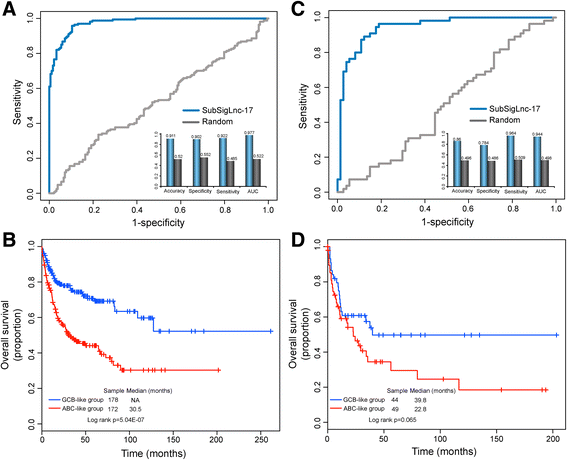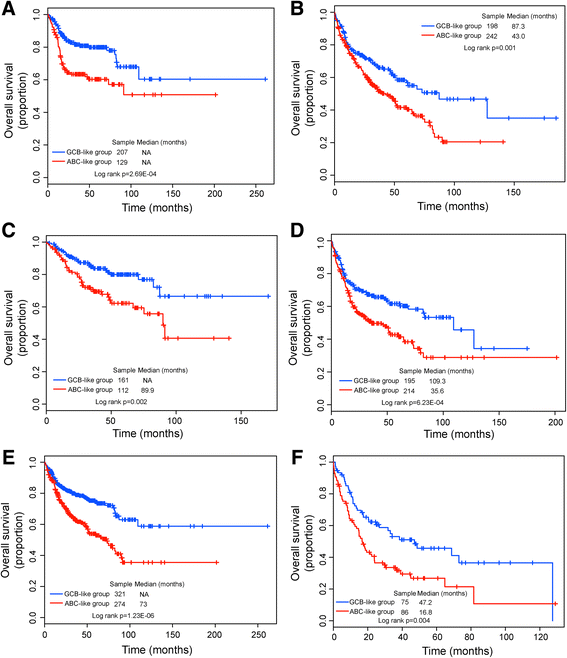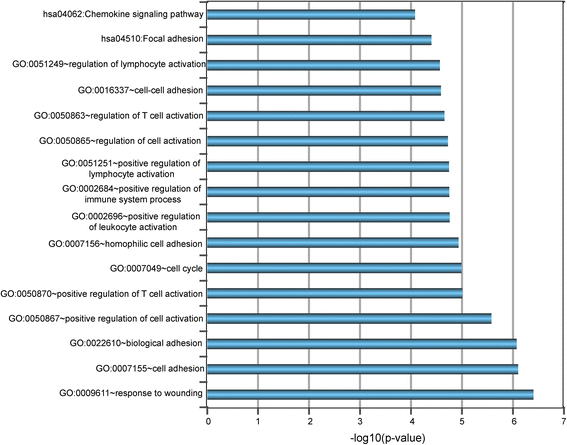Discovery and validation of immune-associated long non-coding RNA biomarkers associated with clinically molecular subtype and prognosis in diffuse large B cell lymphoma
- PMID: 28103885
- PMCID: PMC5248456
- DOI: 10.1186/s12943-017-0580-4
Discovery and validation of immune-associated long non-coding RNA biomarkers associated with clinically molecular subtype and prognosis in diffuse large B cell lymphoma
Abstract
Background: Diffuse large B-cell lymphoma (DLBCL) is an aggressive and complex disease characterized by wide clinical, phenotypic and molecular heterogeneities. The expression pattern and clinical implication of long non-coding RNAs (lncRNAs) between germinal center B-cell-like (GCB) and activated B-cell-like (ABC) subtypes in DLBCL remain unclear. This study aims to determine whether lncRNA can serve as predictive biomarkers for subtype classification and prognosis in DLBCL.
Methods: Genome-wide comparative analysis of lncRNA expression profiles were performed in a large number of DLBCL patients from Gene Expression Omnibus (GEO), including GSE31312 cohort (N = 426), GSE10846 (N = 350) cohort and GSE4475 cohort (N = 129). Novel lncRNA biomarkers associated with clinically molecular subtype and prognosis were identified in the discovery cohort using differential expression analyses and weighted voting algorithm. The predictive value of the lncRNA signature was then assessed in two independent cohorts. The functional implication of lncRNA signature was also analyzed by integrative analysis of lncRNA and mRNA.
Results: Seventeen of the 156 differentially expressed lncRNAs between GCB and ABC subtypes were identified as candidate biomarkers and integrated into form a lncRNA-based signature (termed SubSigLnc-17) which was able to discriminate between GCB and ABC subtypes with AUC of 0.974, specificity of 89.6% and sensitivity of 92.5%. Furthermore, subgroups of patients characterized by the SubSigLnc-17 demonstrated significantly different clinical outcome. The reproducible predictive power of SubSigLnc-17 in subtype classification and prognosis was successfully validated in the internal validation cohort and another two independent patient cohorts. Integrative analysis of lncRNA-mRNA suggested that these candidate lncRNA biomarkers were mainly related to immune-associated processes, such as T cell activation, leukocyte activation, lymphocyte activation and Chemokine signaling pathway.
Conclusions: Our study uncovered differentiated lncRNA expression pattern between GCB and ABC DLBCL and identified a 17-lncRNA signature for subtype classification and prognosis prediction. With further prospective validation, our study will improve the understanding of underlying molecular heterogeneities in DLBCL and provide candidate lncRNA biomarkers in DLBCL classification and prognosis.
Keywords: Biomarkers; Diffuse large B-cell lymphoma; Long non-coding RNAs; Prognosis; Subtype classification.
Figures






Similar articles
-
Predictive analysis of long non-coding RNA expression profiles in diffuse large B-cell lymphoma.Oncotarget. 2017 Apr 4;8(14):23228-23236. doi: 10.18632/oncotarget.15571. Oncotarget. 2017. PMID: 28423571 Free PMC article.
-
A Pooled Analysis of The Clinical Utilities of Long Non-Coding RNA Based Molecular Signature for Diffuse Large B Cell Lymphoma.Clin Lab. 2017 Nov 1;63(11):1831-1840. doi: 10.7754/Clin.Lab.2017.170605. Clin Lab. 2017. PMID: 29226652
-
A potential panel of six-long non-coding RNA signature to improve survival prediction of diffuse large-B-cell lymphoma.Sci Rep. 2016 Jun 13;6:27842. doi: 10.1038/srep27842. Sci Rep. 2016. PMID: 27292966 Free PMC article.
-
Diffuse large B-cell lymphoma.Pathology. 2018 Jan;50(1):74-87. doi: 10.1016/j.pathol.2017.09.006. Epub 2017 Nov 20. Pathology. 2018. PMID: 29167021 Review.
-
The significance of FOXP1 in diffuse large B-cell lymphoma.Leuk Lymphoma. 2017 May;58(5):1037-1051. doi: 10.1080/10428194.2016.1228932. Epub 2016 Sep 27. Leuk Lymphoma. 2017. PMID: 27678023 Review.
Cited by
-
LncRNA OR2A1-AS1 index predicts survival in germinal center-like diffuse large B-cell lymphoma.J Clin Lab Anal. 2022 Oct;36(10):e24680. doi: 10.1002/jcla.24680. Epub 2022 Sep 4. J Clin Lab Anal. 2022. PMID: 36059090 Free PMC article.
-
Immune-related long non-coding RNA signature identified prognosis and immunotherapeutic efficiency in bladder cancer (BLCA).Cancer Cell Int. 2020 Jun 26;20:276. doi: 10.1186/s12935-020-01362-0. eCollection 2020. Cancer Cell Int. 2020. PMID: 32607061 Free PMC article.
-
Advances in Multi-Omics Study of Prognostic Biomarkers of Diffuse Large B-Cell Lymphoma.Int J Biol Sci. 2022 Jan 9;18(4):1313-1327. doi: 10.7150/ijbs.67892. eCollection 2022. Int J Biol Sci. 2022. PMID: 35280688 Free PMC article. Review.
-
A positive feed-forward loop between LncRNA-URRCC and EGFL7/P-AKT/FOXO3 signaling promotes proliferation and metastasis of clear cell renal cell carcinoma.Mol Cancer. 2019 Apr 5;18(1):81. doi: 10.1186/s12943-019-0998-y. Mol Cancer. 2019. PMID: 30953521 Free PMC article.
-
MicroRNAs Associated With Colon Cancer: New Potential Prognostic Markers and Targets for Therapy.Front Bioeng Biotechnol. 2020 Mar 10;8:176. doi: 10.3389/fbioe.2020.00176. eCollection 2020. Front Bioeng Biotechnol. 2020. PMID: 32211396 Free PMC article.
References
-
- Tilly H, Gomes da Silva M, Vitolo U, Jack A, Meignan M, Lopez-Guillermo A, Walewski J, Andre M, Johnson PW, Pfreundschuh M, et al. Diffuse large B-cell lymphoma (DLBCL): ESMO Clinical Practice Guidelines for diagnosis, treatment and follow-up. Ann Oncol. 2015;26(Suppl 5):v116–125. doi: 10.1093/annonc/mdv304. - DOI - PubMed
Publication types
MeSH terms
Substances
LinkOut - more resources
Full Text Sources
Other Literature Sources

